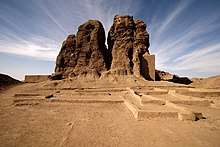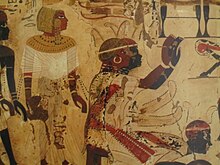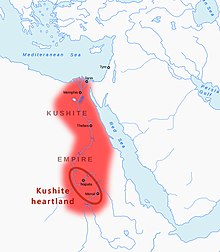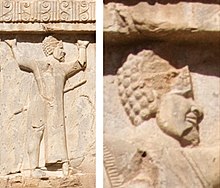Nubia
Nubia was home to several empires, most prominently the Kingdom of Kush, which conquered Egypt in the eighth century BC during the reign of Piye and ruled the country as its 25th Dynasty.
[22] Saharan rock reliefs depict scenes that have been thought to suggest the presence of a cattle cult, typical of those seen throughout parts of Eastern Africa and the Nile Valley even to this day.
[30][31] Dietrich Wildung (2018) examined Eastern Saharan pottery styles and Sudanese stone sculptures and suggested these artefacts were transmitted across the Nile Valley and influenced the pre-dynastic Egyptian culture in the Neolithic period.
The imports consisted of gold objects, copper tools, faience amulets and beads, seals, slate palettes, stone vessels, and a variety of pots.
Scholars from the University of Chicago Oriental Institute excavated at Qustul (near Abu Simbel in Sudan), in 1960–64, and found artifacts which incorporated images associated with Egyptian pharaohs.
[43][44][45][46] According to David Wengrow, the A-Group polity of the late 4th millenninum BCE is poorly understood since most of the archaeological remains are submerged underneath Lake Nasser.
[47] Frank Yurco also remarked that depictions of pharonic iconography such as the royal crowns, Horus falcons and victory scenes were concentrated in the Upper Egyptian Naqada culture and A-Group Nubia.
He further elaborated that "Egyptian writing arose in Naqadan Upper Egypt and A-Group Nubia, and not in the Delta cultures, where the direct Western Asian contact was made, further vitiates the Mesopotamian-influence argument".
[49] The earliest representations of pharaonic iconography have been excavated from Nag el-Hamdulab in Aswan, the extreme southern region of Egypt which borders the Sudan, with an estimated dating range between 3200 and 3100 BC.
Although they are most notable for their protection of the royal palaces and tombs in Thebes and the surrounding areas, the Medjay were deployed throughout Upper and Lower Egypt; they were even used during Kamose's campaign against the Hyksos and became instrumental in turning the Egyptian state into a military power.
[93] Ahmose-Nefertari, "arguably the most venerated woman in Egyptian history",[94] was thought by some scholars such as Flinders Petrie to be of Nubian origin because she is most often depicted with black skin.
[66][95]: 17 [96] The mummy of Ahmose-Nefertari's father, Seqenenre Tao, has been described as presenting "tightly curled, woolly hair", with "a slight build and strongly Nubian features".
: 11–12, 23, 74–5 [101]: 125 Egyptologist Barbara Lesko wrote in 1996 that Ahmose-Nefertari was "sometimes portrayed by later generations as having been black, although her coffin portrait gives her the typical light yellow skin of women.
[86]: 111 The El Kurru chiefdom likely played a major role in the development of the Kingdom of Kush due to its access to gold producing areas, control of caravan routes,[86]: 112 more arable land, and participation in international trade.
[86]: 148 The Napatan Empire ushered in the age of Egyptian archaism, or a return to a historical past, which was embodied by a concentrated effort at religious renewal and restoration of Egypt's holy places.
According to the revised chronology, Shebitku "brought the entire Nile Valley as far as the Delta under the empire of Kush and is 'reputed' to have had Bocchoris, dynast of Sais, burnt to death".
[86] László Török mentions the military success was due to Taharqa's efforts to strengthen the army through daily training in long-distance running and Assyria's preoccupation with Babylon and Elam.
Meroë is mentioned in first-century AD Periplus of the Erythraean Sea: "farther inland, in the country towards the west, there lies a city called Meroe".
The town's importance gradually increased from the beginning of the Meroitic Period, especially from the reign of Arakamani (c. 280 BC) when the royal burial ground was transferred to Meroë from Napata (Jebel Barkal).
Excavations revealed evidence of important, high ranking Kushite burials, from the Napatan Period (c. 800 – c. 280 BC) in the vicinity of the settlement called the Western cemetery.
[144] Kandake, often Latinised as Candace, was the Meroitic term for the sister of the king of Kush who, due to matrilineal succession, would bear the next heir, making her a queen mother.
[147][148] In the New Testament biblical account, a treasury official of "Candace, queen of the Ethiopians", returning from a trip to Jerusalem, met with Philip the Evangelist and was baptized.
[118]: 65–66 Derek Welsby states "scholars have doubted that this Persian expedition ever took place, but... archaeological evidence suggests that the fortress of Dorginarti near the second cataract served as Persia's southern boundary.
"[118]: 65–66 The Greek Ptolemaic Kingdom under Ptolemy II Philadelphus invaded Nubia in 275 BC and annexed the northern twelve miles of this territory, subsequently known as the Dodekaschoinos ('twelve-mile land').
[157] Alerted to the advance, Petronius again marched south and managed to reach Qasr Ibrim and bolster its defences before the invading Kushites arrived.
King Silky of Nobatia defeated the Blemmyes and recorded his victory in a Greek language inscription carved in the wall of the temple of Talmis (modern Kalabsha) around 500 AD.
The populations were possibly influenced by migration waves coming from the north, but these movements did not prevent repeated contacts of the people of Nubia with other regions further south in Africa.
[164] Craniometric analysis of Kerma fossils that compared them to various other early populations inhabiting the Nile Valley and Maghreb found that they were morphologically close to Predynastic Egyptians from Naqada (4000–3200 BC).
[169] Sirak et al. 2021 obtained and analyzed the whole genomes of 66 individuals from the site of Kulubnarti situated in northern Nubia between the 2nd and 3rd cataract, near the modern Egyptian border, and dated to the Christian period between 650 and 1000 CE.
[171] In 2022, DNA was sequenced from the hair of a Kerma period individual (4000 BP), and the results revealed close genetic affinity to early pastoralists from the Rift Valley in eastern Africa during the Pastoral Neolithic.




















